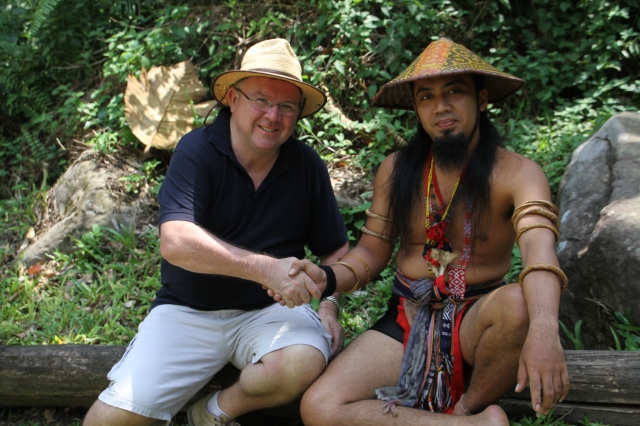 I read a remarkable book last night called My Name is Mary Sutter by Robin Oliveira, about a young midwife in the 1860s who wants to become a surgeon years before women were accepted into medical schools. It is not until she serves as a nurse in the American Civil War and learns the trade through overwhelming, ghastly necessity that she is eventually accepted.
I read a remarkable book last night called My Name is Mary Sutter by Robin Oliveira, about a young midwife in the 1860s who wants to become a surgeon years before women were accepted into medical schools. It is not until she serves as a nurse in the American Civil War and learns the trade through overwhelming, ghastly necessity that she is eventually accepted.
It was a fascinating but increasingly difficult book to read, as page after page had descriptions of the horror and suffering of the war wounded on a scale unimaginable. Her mental images of squalid, disease ridden hospitals, where doctors had no idea that filth and squalor caused disease and infection, and where most patients died long, lingering and painful deaths are graphic and detailed, but her hero, the strong and determined Mary is a gallant, gutsy role model for everyone. Robin Oliveira’s research has obviously been meticulous, but she has not let that overwhelm decent, page-turning storytelling. I couldn’t put it down.
 I had read somewhere that Louis M Alcott, the author of Little Women, had also worked as a Civil War nurse in Georgetown, D.C, where she, not surprisingly, contracted typhoid fever. It wasn’t until last night that I had some understanding of how traumatic that experience of being a nurse back then must have been, and how her whole life must have been distorted by those times.
I had read somewhere that Louis M Alcott, the author of Little Women, had also worked as a Civil War nurse in Georgetown, D.C, where she, not surprisingly, contracted typhoid fever. It wasn’t until last night that I had some understanding of how traumatic that experience of being a nurse back then must have been, and how her whole life must have been distorted by those times. 
Here are some reviews I took from Robin Olivera’s website.
MY NAME IS MARY SUTTER is a remarkable book, one of the most assured first novels I’ve read in a long, long time. Robin Oliveira brings the Civil War era vividly alive, and her heroine is a character who, once encountered, few readers will forget. Bravo!
— Ron Rash author of Serena, Saints at the River
In MY NAME IS MARY SUTTER it seems as though Robin Oliveria brought Mary Sutter back to life rather than imagined her. With her description of the Sutter home, the reader becomes a guest at the dinner table. This is a finely written novel of the medical failings and opportunities presented by the war. But it is really the story of a woman who lives her life with the passion and stubbornness needed to take her through the strains of battlefield hospital work, through her grief for family loses and the war wounded; it is the story of the extraordinary need that propels her to become a surgeon. Even in the darkest days, Mary’s enormous compassion and healing touch shine forth. Thank you so much for sharing it with me.
— Mary Gay Shipley, owner of That Bookstore in Blytheville
Oliveira’s voice is urgently compelling in its detail and so authentically pitched, she might have been transported directly from the tumult of Civil War Washington to report this story.
— Debra Dean, author of The Madonnas of Leningrad
“MY NAME IS MARY SUTTER is a magnificent Civil War epic, a saga of female liberation and a gorgeous love story. Mary Sutter’s quest to become a surgeon when women were barely allowed to be nurses is one of the great untold stories of American history. She is indomitable, fearless and captivating. From Ireland’s Corners, New York, to the over-crowded hospitals of Washington to battlefield surgeries to a meeting with Abraham Lincoln himself, Mary Sutter’s progress is gritty and passionate–a riveting read.”
— Douglas Glover, author of Elle
“There’s more than a whiff of the classic in Robin Oliveira’s charming, compulsively readable historical tale about Mary Sutter, a young midwife and aspiring physician making her way through Lincoln’s war–a new iconic American heroine.”
— Janice Lee, author of The Piano Teacher
“MY NAME IS MARY SUTTER is a powerful debut – equally compelling for its portrayal of the horrors of surgery during the Civil War as it is for its human drama. Mary Sutter is unforgettable, not just because she’s quirky, odd and persistent in her quest to be a surgeon, but also because she is alive inside anyone who knows what it is to dream.”
— Xu Xi, author of The Unwalled City
I am deeply impressed by MY NAME IS MARY SUTTER. Oliveira weaves the strands of civil war history, history of medicine into a novel with dynamic and believable characters. Mary is a wonderful heroine, with extraordinary gifts and weaknesses too. That every man is in love with her is no wonder. A thrilling debut.
— Carla Cohen, Politics and Prose Bookstore
“A vivid, dramatic novel about love, medicine, and the Civil War, MY NAME IS MARY SUTTER features an indomitable, memorable heroine whom the reader will root for until the very end.”
— David Ebershoff, author of The 19th Wife and The Danish Girl
“Historical tale among best… enthralling and well-researched debut novel…”
— Atlanta Journal Constitution
“…This impressive historical epic deserves a large readership.”
— Booklist
“… This unforgettable novel of the American Civil War should become a classic. I highly recommend My Name Is Mary Sutter to readers who wish to gain a better understanding of the war and its effects on those who lived through it.
— Historical Novels Review – Editors’ Choice
“…Oliveira’s scrupulously factually researched canvass allows its readers to witness through human experience the agonizingly complex relationship of disease, mutilation, death, and healing in war.”
— Journal of American Medical Association









 Tom Price Primary School
Tom Price Primary School












